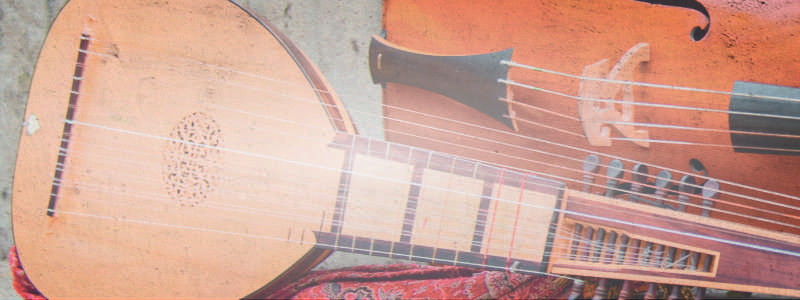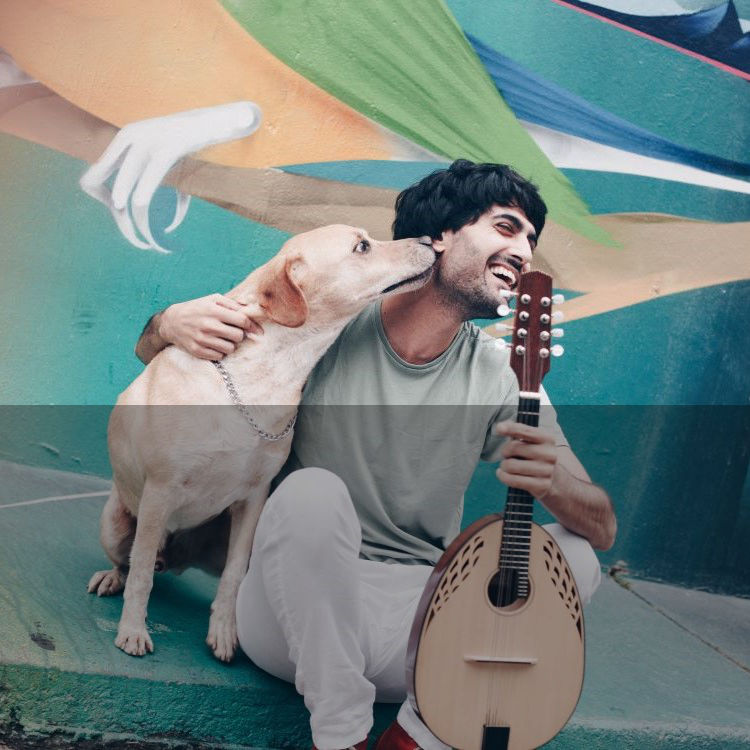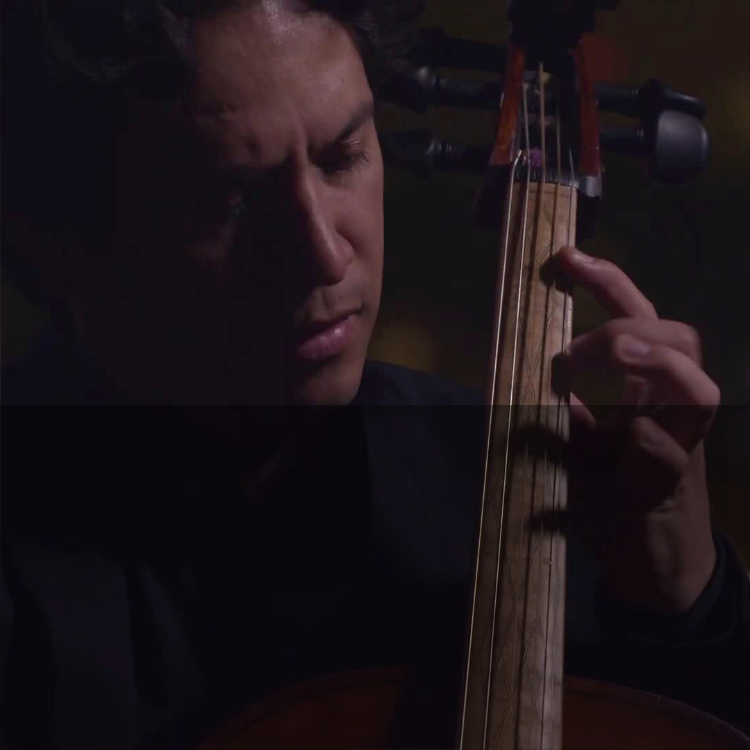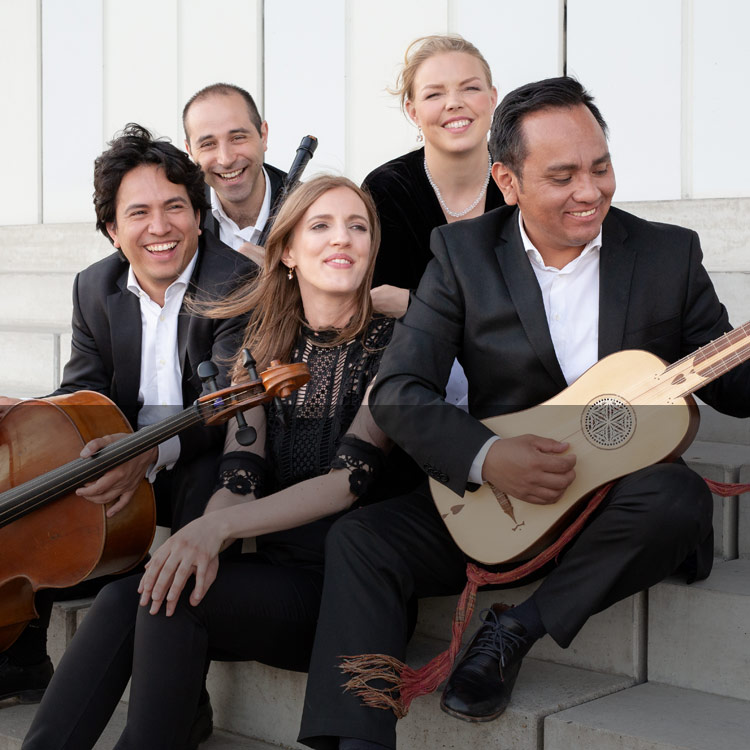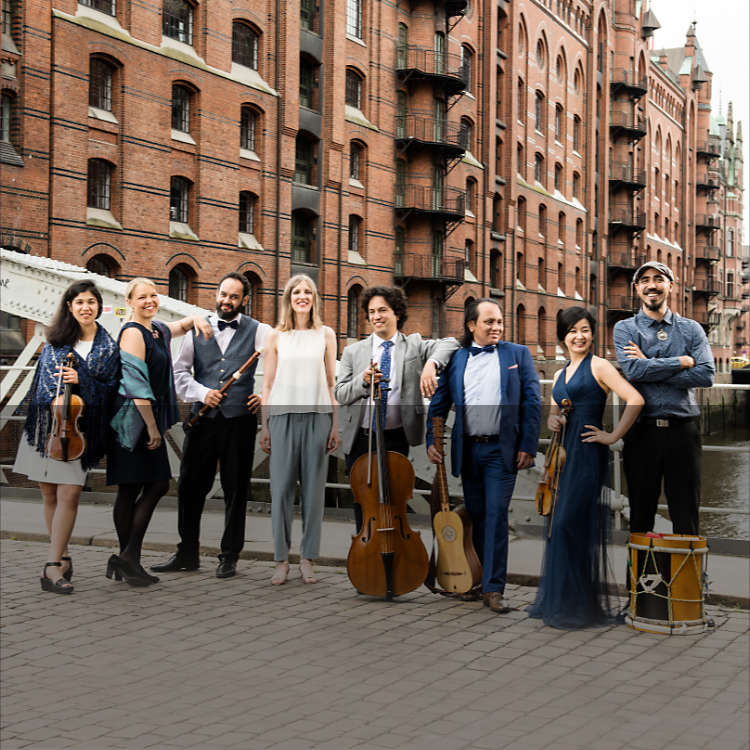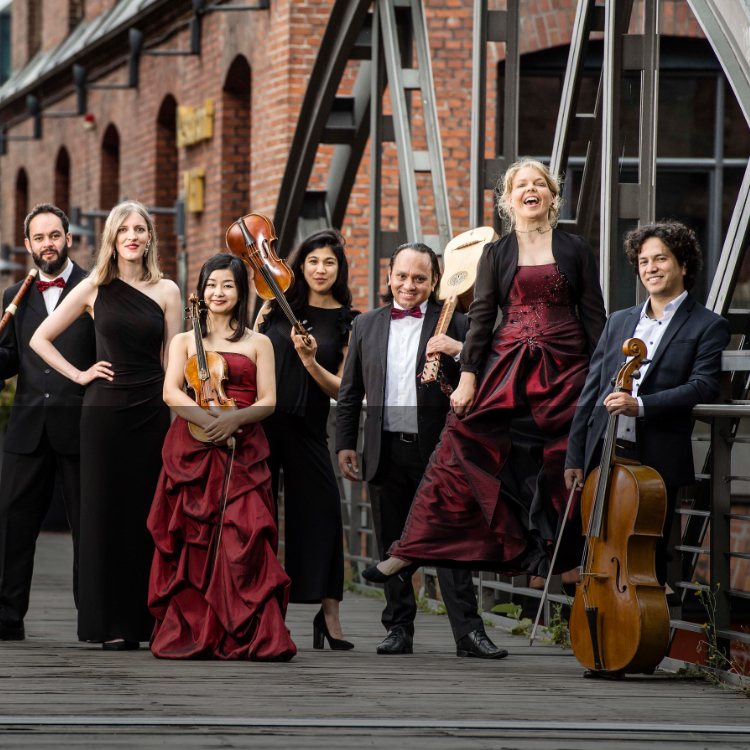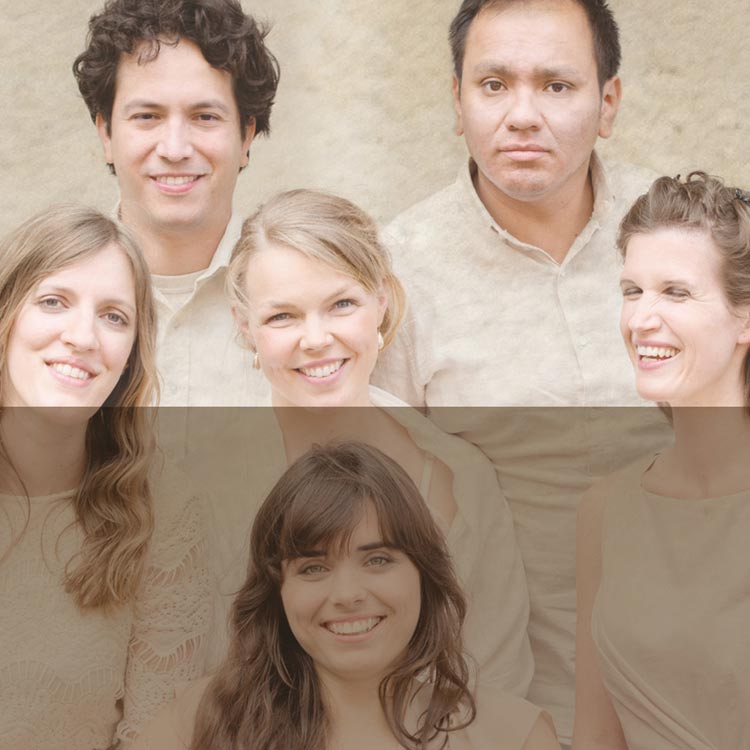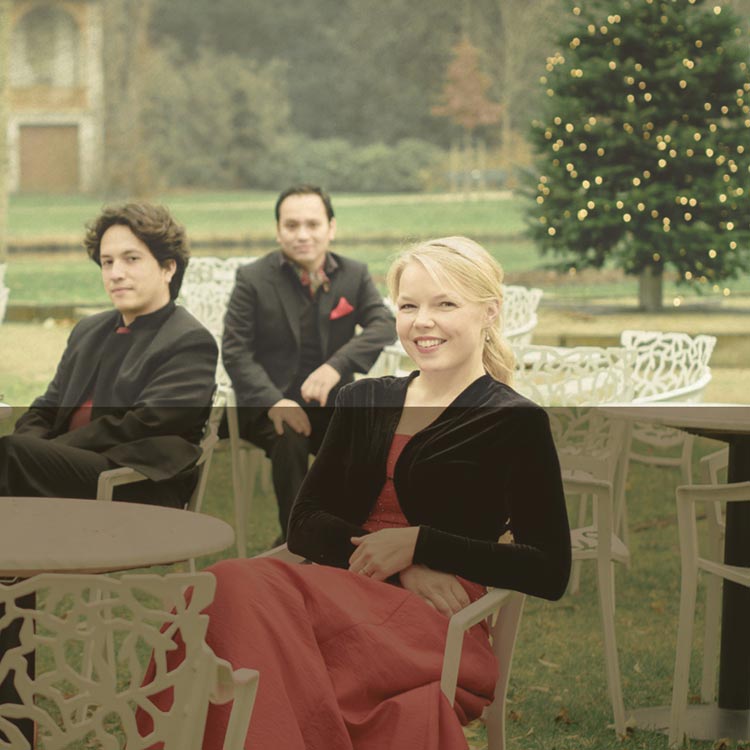The mandolin is a small all-rounder. Its versatility is demonstrated with great enthusiasm in this program, in which Los Temperamentos, together with soloist Alon Sariel, explore the world of this fascinating instrument. In the hands of instrumental virtuoso and Opus Klassik award winner Sariel, this charming instrument becomes a musical ambassador of the Iberian Peninsula in this concert.
With works spanning five centuries, the artists present a diverse program that ranges from Baroque virtuosity and Sephardic yearning melodies to famous Spanish national compositions of the 20th century. Music by Domenico Scarlatti, Gian Francesco de Majo, and Aleixo de Botelho Ferreira blends tastefully with early Spanish Baroque and the folklore of Sephardic and Moorish heritage. With Isaac Albéniz, Pablo de Sarasate, and Francisco Tárrega, the musical narrative finally enters the 20th century. The famous "Recuerdos de la Alhambra" and "Asturias" evoke dreams of a warm Spanish musical summer night.
4 Musicians: Mandolin, Violoncello, Harpsichord, Baroque Guitar
With works spanning five centuries, the artists present a diverse program that ranges from Baroque virtuosity and Sephardic yearning melodies to famous Spanish national compositions of the 20th century. Music by Domenico Scarlatti, Gian Francesco de Majo, and Aleixo de Botelho Ferreira blends tastefully with early Spanish Baroque and the folklore of Sephardic and Moorish heritage. With Isaac Albéniz, Pablo de Sarasate, and Francisco Tárrega, the musical narrative finally enters the 20th century. The famous "Recuerdos de la Alhambra" and "Asturias" evoke dreams of a warm Spanish musical summer night.
4 Musicians: Mandolin, Violoncello, Harpsichord, Baroque Guitar
The longing view of the night sky, the mysterious twinkling of distant stars, the sense of infinity. Stelle Amorose unfolds musical narratives in which the stars play a central role — as guides, divine entities, or as mirrors of the human soul.
Los Temperamentos follows the footsteps of authors and protagonists across Baroque Europe to Mexico. Among other things, they perform rarely performed songs and arias from the Cancionero Musicale of the Cathedral of Oaxaca and the Italian Como manuscript.
The familiar song The Moon Has Risen also makes a surprising guest appearance in this concert: True to its 18th-century origins, it is performed in a touching chamber music arrangement by N. F. Cortés Garzón.
Featuring works by A. Fioré, J. H. Schmelzer, G. Fernandes, B. Storace, and the Chiquitos Codex, among others.
6-7 musicians: Vocals, Violins, Violoncello, Guitar/Lute, Harpsichord
Los Temperamentos follows the footsteps of authors and protagonists across Baroque Europe to Mexico. Among other things, they perform rarely performed songs and arias from the Cancionero Musicale of the Cathedral of Oaxaca and the Italian Como manuscript.
The familiar song The Moon Has Risen also makes a surprising guest appearance in this concert: True to its 18th-century origins, it is performed in a touching chamber music arrangement by N. F. Cortés Garzón.
Featuring works by A. Fioré, J. H. Schmelzer, G. Fernandes, B. Storace, and the Chiquitos Codex, among others.
6-7 musicians: Vocals, Violins, Violoncello, Guitar/Lute, Harpsichord
With "Fiesta Peruana" Bremen based ensemble Los Temperamentos presents a unique concert evening: This programme features the fascinating music of the famous codex "Martinez Compañón" and dances choreographed especially for the occasion in elaborate costumes that were inspired by original images within the codex. The ensemble brings Peruvian music of the 18th century back to life, reflecting an unsuspected cultural diversity of European, African and indigenous roots; recorded and transported into the present in arrangements by the ensemble's artistic leader Néstor F. Cortés Garzón.
In this concert, not only artists from many different nations meet, but also two centuries, two eras. As early music specialists, Los Temperamentos have toured concert stages all over the world, presenting their very own, unmistakable sound, which always oscillates between the 'then' and the 'now' and is particularly praised for its effervescent vitality.
This programme can also be performed without dancers.
12 musicians: Vocals, Violins, Transverse flute, Violoncello, Double bass, Baroque guitar/Lute, Harpsichord, Percussion;
4 Dance couples
In this concert, not only artists from many different nations meet, but also two centuries, two eras. As early music specialists, Los Temperamentos have toured concert stages all over the world, presenting their very own, unmistakable sound, which always oscillates between the 'then' and the 'now' and is particularly praised for its effervescent vitality.
This programme can also be performed without dancers.
12 musicians: Vocals, Violins, Transverse flute, Violoncello, Double bass, Baroque guitar/Lute, Harpsichord, Percussion;
4 Dance couples
This two-part program not only brings together different musical worlds, but also different concert formats.
While the baroque ensemble's acoustic instruments meet traditional Colombian music in the first half of the evening, robust electronic beats are added in the second half, and with Colombian multi-instrumentalists Edwin Hoyos and Leang Manjarrés, the gaita flute becomes the star of the show.
This program is predestined for unusual concert venues. In a hall without rows of seats, the audience is expressly encouraged to be close to the action and to dance!
The pieces will include Colombian traditionals such as "Sombrerito Blanco," "Candelaria," and "Campo Alegre," as well as original compositions by L. Manjarrés, N. Cortés, and N. Remmert.
10-12 musicians: Vocals, Violins, Flute/Gaita, Violoncello, Guitar, Harpsichord, Double Bass, Percussion, Loop station | Sound engineer (sound system required)
While the baroque ensemble's acoustic instruments meet traditional Colombian music in the first half of the evening, robust electronic beats are added in the second half, and with Colombian multi-instrumentalists Edwin Hoyos and Leang Manjarrés, the gaita flute becomes the star of the show.
This program is predestined for unusual concert venues. In a hall without rows of seats, the audience is expressly encouraged to be close to the action and to dance!
The pieces will include Colombian traditionals such as "Sombrerito Blanco," "Candelaria," and "Campo Alegre," as well as original compositions by L. Manjarrés, N. Cortés, and N. Remmert.
10-12 musicians: Vocals, Violins, Flute/Gaita, Violoncello, Guitar, Harpsichord, Double Bass, Percussion, Loop station | Sound engineer (sound system required)
Los Temperamentos dedicates this program to the joy of playing ostinatos. An ostinato is a repeating bass figure above which ever-new melodies and variations can unfold. Hardly any other form inspired Baroque musicians and composers as much as this one. It symbolizes endless diversity, springing from a source of just a few notes.
But it's not just the legendary ciacona, handed down in countless variations, that will be heard in this concert: Los Temperamentos draw on a wide variety of ostinato basses that circulated throughout Europe as early as the Baroque period, and whose origins remain partly obscure.
The appeal of this music lies in repeatedly surprising the listener, transforming the recurring, and thus creating something new. For the ensemble, it's a playground full of improvisation, humor, and virtuosity where past and present meet.
The program includes works by B. Strozzi, J.-H. D'Anglebert, A. Soler, et al.
6-7 musicians: Vocals, Violins, Recorders, Violoncello, Harpsichord/Organ, Percussion
But it's not just the legendary ciacona, handed down in countless variations, that will be heard in this concert: Los Temperamentos draw on a wide variety of ostinato basses that circulated throughout Europe as early as the Baroque period, and whose origins remain partly obscure.
The appeal of this music lies in repeatedly surprising the listener, transforming the recurring, and thus creating something new. For the ensemble, it's a playground full of improvisation, humor, and virtuosity where past and present meet.
The program includes works by B. Strozzi, J.-H. D'Anglebert, A. Soler, et al.
6-7 musicians: Vocals, Violins, Recorders, Violoncello, Harpsichord/Organ, Percussion
Seafaring was a central theme in the 17th and 18th centuries: for some, a place of trade, for others, a glorified place of longing, full of adventure. But the sea also meant danger – wars, raids, and storms were commonplace and gave rise to legends on the mainland.
In Baroque France, the "Matelots" became popular theater figures, privateers and pirates joined the action, musical storms allowed composers to evoke the power of the elements, and songs told of daring expeditions and passionate romances on the high seas. Los Temperamentos takes up this Baroque adventure and brings the stories of the sea to life in sound and joy.
Featuring Baroque music from the Caribbean, the Mediterranean, the Netherlands, and England
6-8 musicians: Voice, Violin, Viola, Traverso, Violoncello, Harpsichord, Percussion
In Baroque France, the "Matelots" became popular theater figures, privateers and pirates joined the action, musical storms allowed composers to evoke the power of the elements, and songs told of daring expeditions and passionate romances on the high seas. Los Temperamentos takes up this Baroque adventure and brings the stories of the sea to life in sound and joy.
Featuring Baroque music from the Caribbean, the Mediterranean, the Netherlands, and England
6-8 musicians: Voice, Violin, Viola, Traverso, Violoncello, Harpsichord, Percussion
00:00
When, after a hard day's work in the Colombian Choco, one could finally drift comfortably down the river and the water set the tempo and rhythm of life, those soulful verses and melodies were created that Los Temperamentos take up in this programme.
Agua bajo literally means "downstream" and at the same time stands for the very art of improvising songs and poems that has been passed down from generation to generation in Colombia for centuries.
The focus of this programme is on the rich and varied musical tradition of Colombia, whose strong African roots are particularly evident in the music of Palenque.Palenque is still the name given to the villages that escaped slaves founded in order to build up their own existence. Here, in complete isolation, unique traditions emerged as early as the 16th century, which Néstor Cortés takes up in his compositions and arrangements and interweaves with the baroque sound language of Europe and its instruments to create a unique sound experience.
8-10 musicians: Vocals, Violins, Traverso/Gaita, Violoncello, Baroque Guitar/Lute, Harpsichord, Percussion
Agua bajo literally means "downstream" and at the same time stands for the very art of improvising songs and poems that has been passed down from generation to generation in Colombia for centuries.
The focus of this programme is on the rich and varied musical tradition of Colombia, whose strong African roots are particularly evident in the music of Palenque.Palenque is still the name given to the villages that escaped slaves founded in order to build up their own existence. Here, in complete isolation, unique traditions emerged as early as the 16th century, which Néstor Cortés takes up in his compositions and arrangements and interweaves with the baroque sound language of Europe and its instruments to create a unique sound experience.
8-10 musicians: Vocals, Violins, Traverso/Gaita, Violoncello, Baroque Guitar/Lute, Harpsichord, Percussion
Iguanas, parrots, snakes and vultures form the framework for this programme, in which everything revolves around baroque ostinati, dances and elaborate variations that are connected in various ways with the animal kingdom. Whether they call for an ecstatic dance like the famous "Los Pollos", tell of Mexican village life or sing of the beloved "little pigeon"; already centuries ago, people and societies across continents connected through the playing of these melodies, which were already widespread in the Baroque era through oral tradition. Composers were also inspired by them, and so eventually even the courtly music of Europe was influenced by the well-known folk songs. Even today, these baroque 'cornerstones' are a living part of culture in many places, such as "Los Pollos" (the chickens), a song that every child in Mexico can whistle along to like the children in this country whistle "Alle mein Entchen"...
Works from Mexico, Colombia, Peru, Spain, etc.
9-10 musicians: vocals, baroque violins, traverso, baroque violoncello, baroque guitar/lute, harpsichord, percussion
Works from Mexico, Colombia, Peru, Spain, etc.
9-10 musicians: vocals, baroque violins, traverso, baroque violoncello, baroque guitar/lute, harpsichord, percussion
In this concert, Los Temperamentos will lead the audience into times long ago and places far away; into the Spanish speaking world of 300 years ago. This was a world continuously in a state of change – as our world is now. With the program, “Entre dos Tiempos”, the Ensemble brings a colourful and exciting concert to the stage that is intensified by the rhythmic and dance elements of baroque music from Latin America and Southern Europe. The title encompasses the sense of a duality of human life, of music and overarching existence. The program incorporates emotions and exotic cross rhythms of South America’s pre colonization which finds itself spanning the divide between European and pre European culture. The music reflects life, as life itself was a dance continually changing its beat.
With pieces from Middle and South America as well as southern Europe.
7-8 musicians
With pieces from Middle and South America as well as southern Europe.
7-8 musicians
00:00
In this program it is all about Love and Madness. The ensemble addresses a question as old as mankind itself: Can there be passion without insanity? Is passion, after all, emerging from insanity? During the concert, the audience is introduced to the baroque composers’ various takes on this matter and as usually Los Temperamentos add to those works their unique Latin American-European inspired way of interpretation. The ensemble will present works by famous Baroque composers as well as rediscovered treasures by still unknown masters: A music full of wild thirst for revenge and baroque reverie interwoven with wonderful intimate moments and lively, danceable improvisations.
A.o. with works by F. Mancini, J. Eccles and P. Giramo
7 musicians
A.o. with works by F. Mancini, J. Eccles and P. Giramo
7 musicians
00:00
ʺEl Galeón 1600ˮ represents the voyage between two worlds: a journey taken by many after the European conquest of Latin America. Whether rich or poor, aristocrat or slave, the travelers carried their cultural heritage with them which resulted in a unique blend of traditions of the Southern and Northern hemispheres. Los Temperamentos traces their path in a musical way as they revive those travelers’ lively spirit for adventure and nostalgia for the past with an extraordinary repertoire of sentimental songs as well as lively Tonadas and instrumental music. Baroque music from Italy and Latin America will be performed to convey the complex mix of musical traditions that emerged in this eventful century.
A.o. with works from the ʺArchivo Musical de Chiquitosˮ and composers such as T. Merula, A. Stradella and D. Scarlatti
6 musicians
A.o. with works from the ʺArchivo Musical de Chiquitosˮ and composers such as T. Merula, A. Stradella and D. Scarlatti
6 musicians
00:00
The arrival of the European »Conquistadores« in the Caribbean at the end of the fifteenth century with the intention of claiming the Americas for themselves marked the dawn of a new era. This brutal beginning led to the radical extermination of entire cultures, whose traditions were irretrievably lost. Despite this massive loss, a few traces of indigenous musical practices survived in many different forms, such as in the music brought back by the Europeans from the “Old World” and in that of the people taken from Africa to be used as slaves. South American music that returned with the Europeans made its own impact as well, particularly on the Iberian Peninsula and the then Spanish-ruled Netherlands and Naples. This program shows a summary of several hundred years of cultural and musical history.
A.o. with works by A. Bertali, J.Klein, J. Marín and from the peruvian Codex »Martínez Compañón«
5 musicians
A.o. with works by A. Bertali, J.Klein, J. Marín and from the peruvian Codex »Martínez Compañón«
5 musicians
00:00
The forty days of Lent, which in Christianity serves as a time of contemplation and preparation for the feast of Easter, is one of the major sources of inspiration for composers of European liturgical music. Inthe Baroque Era there were a great variety of compositions that are based on the theme of Lent. "Los Temperamentos" performs a selection of compositions in contrasting styles in this program. The ensemble repeatedly emphasises new aspects of the old famous compositions and introduces audiences to obscure, forgotten compositions. For example they perform a variety of music ranging from the dramatic works of Caldara to the intimate songs of the East Frisian composer Erlebach. Born in Esens the musician and composer is one of the less performed of the baroque masters, although his works show great skill and emotionality.
With works by Caldara, Erlebach, Telemann, etc.
5-7 musicians
With works by Caldara, Erlebach, Telemann, etc.
5-7 musicians
The program combines South American and European Christmas music. It includes a variety of diverse baroque sounds ranging from Mexican Marizapalos songs to adaptations of traditional German Christmas chants. Los Temperamentos present a mixture of contemplative and cheerful instrumental and vocal compositions that reflect the festive customs of their different cultures. Amongst others this concert comprises works of the Peruvian codex “Martínez Compañón” - an impressive contemporary witness of the Christianization in 17th and 18th century Latin America - and European music from Italy by such composers as Domenico Zipoli or the rarely performed but all the more interesting Cristofaro Caresana.
6-8 Musicians
6-8 Musicians

